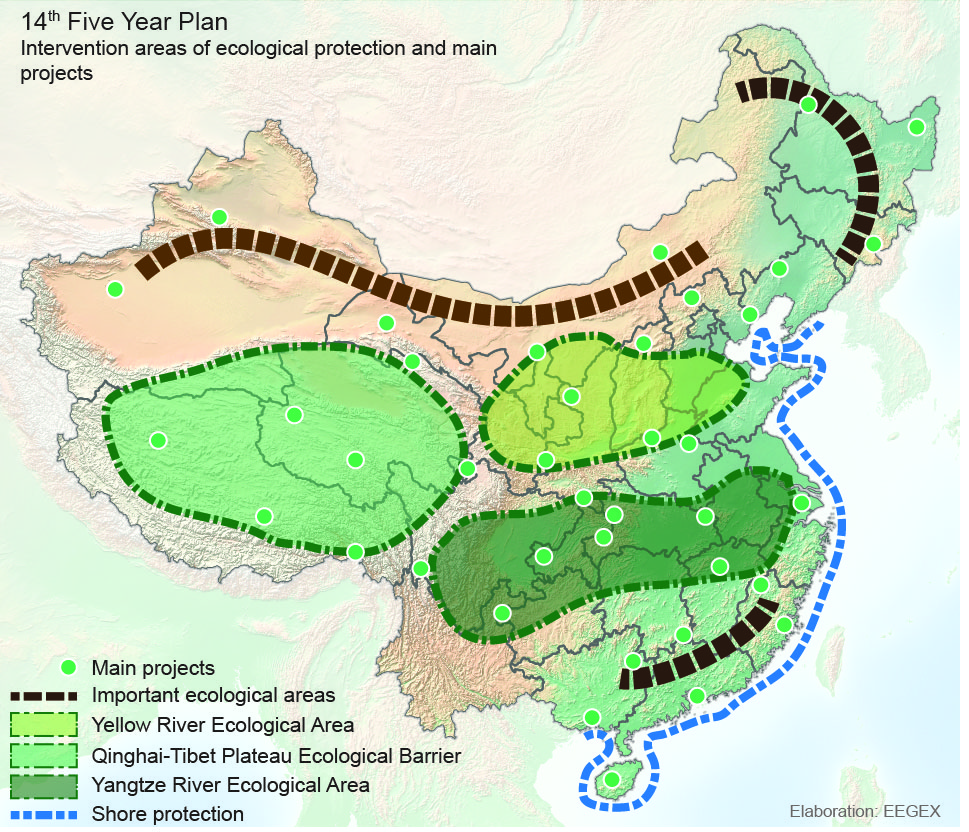Ecological and environmental protection
Last update: November 2022
Among the 5 binding indicators listed in in the “Green Ecology” section in Title 1 of Article 3 of the 14th FYP, two binding indicators (#14 and #15) are related to reduction of carbon intensity and energy intensity, the other are related to environmental protection:
- #16 increase the percentage of days with good air quality, in cities at the prefecture level and above, from 87% to 87.5%;
- #17 increasing the percentage of surface water beyond the 3rd class from 83.4% to 85%
- #18 rising the percentage of forest coverage from 23.2% to 24.1%
The three articles of Title 11 are dedicated to green development and environmental and ecological protection: “Promoting Green Development and promoting the harmonious coexistence of Mankind and Nature”.
Article 37 focuses on "improving the quality and stability of ecosystems", for which this Plan gives a qualitative leap in the approach, evolving the previous management organized by "pilot areas" into a more organic vision, through a general mapping of the macro-areas of intervention, for which it will be necessary to arrive at a systemic management (Figure 17).

The Article looks at the three large macro areas that impact on the generation of water reserves in China (the Qinghai-Tibet plateau, the Yellow River basin and the Yangtze River basin); in addition, explicit reference is made to the fight against desertification and reforestation of the northern borders, the protection of the forests of the north-east, the protection of wetlands (55% of which are placed in a protected park regime), the fight against coastal erosion.
The systemic approach, therefore, concerns the determination of all those sensitive areas that must be placed under a protection regime, within which to initiate ecological restoration and preservation policies, accompanied by monitoring and control policies. No less than 270,000 square kilometers (about 90% of the Italian territory) are affected by the priority projects for ecological restoration and preservation and wildlife protection.
The Article also addresses the issue of ecological compensation, also providing for the implementation of financial mechanisms, however the objectives still seem to be linked to an experimentation phase through pilot projects.
Article 38 focuses on "continuous improvement of environmental quality" and is certainly the one that had the widest media coverage, because it confirms the Chinese government's objectives to reach the peak of carbon emissions by 2030 and to achieve carbon neutrality by 2060. How to achieve the 2030 goal is left to the drafting of an Action Plan, not yet defined, which will have to manage an energy transition that reduces energy consumption in general, energy intensity and incentivize energy sources to low carbon emissions.
The article, however, goes far beyond the climatic aspects, setting specific objectives for the containment of pollution.
As for the air, a 10% reduction of fine particulate PM2.5 is foreseen in the cities at prefecture level and above, for the first time the goal of increasing the concentration of ozone is set (but no parameter has been defined) and an overall reduction of 10% of VOC and NOx emissions is expected.
As for water, an 8% reduction of both COD and nitrates, the elimination of water below the 5th category, the complete coverage of sewers in urban areas and the treatment of 90% sludge from non-harmful purification, mainly through centralized incineration plants, the reuse of 25% of waste water in prefectures that have water supply difficulties.
With regard to waste management, the implementation of sorted waste collection at national level is envisaged, the construction of centralized systems at the prefecture level for the treatment of medical waste and industrial waste treatment plants in the vicinity of major industrial parks.
Emphasis is placed on the need to improve the control and prevention of environmental risks and to improve environmental governance, through the further refinement of the monitoring and management systems already implemented with the previous five-year plans.
Article 39 gives space to the "acceleration of the Development green transition".
The emphasis is on energy saving, without providing indicators, while a reduction in water consumption of 16% per unit of GDP is expected. A general concept of containment of land use is promoted and to maintain building permits for new land under 2 million hectares.
The circular economy is promoted in generic terms, hoping for the implementation of tax and tariff policies that take into account the use of resources and emissions.
In conclusion, the 14th Five-Year Plan addresses in a much more specific way some issues concerning the objectives of ecological protection and management of the main sensitive areas, but it does not specifically address the issue of the improvement of market mechanisms, nor it mentions any reform of public concessions and PPP projects for a wider opening to the private sector.
As happened with the 13th Five-Year Plan, now the responsibility passes to the State Council and the relevant Ministries, which will have to prepare the Action Plans that will address both administrative and regulatory actions, but the setting of the 14th FYP, net of important political declarations, is clearly a transition plan, aimed at consolidating the reforms implemented in the previous two Five-Year Plans, but which in some respects seems to take time, postponing to the next Five Year Plan more critical decisions linked to the structuring of the market, a slowdown that seems to want to adapt to the overall pace of the country's economic and urban development and it is consistent with the 10 year delay of the goal of carbon neutrality (2060 instead of 2050).